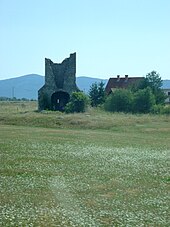Bosanski Petrovac
|
Bosanski Petrovac Босански Петровац |
||
|
|
||
| Basic data | ||
|---|---|---|
| State : | Bosnia and Herzegovina | |
| Entity : | Federation of BiH | |
| Canton : | Una-sana | |
| Coordinates : | 44 ° 33 ' N , 16 ° 22' E | |
| Height : | 650 m. i. J. | |
| Area : | 717 km² | |
| Residents : | 7,946 | |
| Population density : | 11 inhabitants per km² | |
| Structure and administration (as of 2016) | ||
| Mayor : | Zlatko Hujić (independent) | |
| Website : | ||
Bosanski Petrovac ( Serbian - Cyrillic Босански Петровац ) is a city and municipality ( Općina ) in the northwestern part of Bosnia and Herzegovina . It belongs to the Una-Sana canton of the Federation of Bosnia and Herzegovina .
geography
The city is located on Magistral Road 5 from Bihać to Sarajevo .

The large municipality has an area of 717 km²; before the division of the large parish as a result of the Dayton Treaty , it was 853 km². Almost two thirds of this area is forested.
Geographically, the Općina is divided into two areas: on the one hand, fertile valleys where agriculture is possible. The valleys are enclosed by mountains of up to 1795 m. The partly wooded hilly landscape, in which the main town is also located, forms a second section.
The climate is mild-continental with an average temperature of 20 to 22 degrees Celsius in July and −2 to +2 degrees Celsius in December and January.
history
Remains of a Roman trade route indicate a settlement already in antiquity.
The Serbian Orthodox Peter and Paul Cathedral was built in the city from 1890 to 1891 .
During the Second World War, Tito and the partisan high command used the city as a base for a few months. The partisans central hospital was located nearby. After the Second World War, the museum of the Bosanski Petrovac poet Skender Kulenović was established .
During the Bosnian War the Općina was fiercely contested. The city itself suffered little damage, while all surrounding towns were destroyed to at least 50 percent.
Before the war, mostly Bosnian Serbs lived in the Općina, especially in the north and south of the administrative district, which today forms the Opština Petrovac-Drinić (RS).
population
The larger community had 15,621 inhabitants in 1991, of which 11,694 identified themselves as Serbs (74.9%), 3,288 as Bosniaks (21%) and 639 as members of other ethnic groups.
In the city itself, the 2,678 Bosniaks were the largest group (49.8%). 2,345 residents called themselves Serbs (43.6%). In contrast, there was an absolute Serb majority in most of the smaller towns in the municipality. Only two villages were predominantly Muslim.
The war resulted in significant population shifts. In 1998, 6,963 Bosniaks, 474 Bosnian Serbs, 17 Bosnian Croats and 1 member of other ethnic groups were counted, most of them displaced. With the total number of 7,455, the reduction of the territory by around 145 km² must be taken into account, but there was still a great loss of population.
The last census in 2013 counted 3,996 Serbs, 3,179 Bosniaks, 26 Croats and 127 members of other ethnic groups.
Personalities
- Mane Rokvić (* in Kolunić ; † 1944 ), Serbian Chetnik leader and war criminal
See also
- Oštrelj (Bosanski Petrovac) , a village in the Bosanski Petrovac municipality
- Petrovac (Republika Srpska) , a union municipality (opština) belonging to the Republika Srpska, which was separated from Bosanski Petrovac as a result of the Dayton Agreement.
Web links
Individual evidence
- ↑ a b Report on Bosanski Petrovac by the Federal Commissioner for Refugee Return, Reintegration and Reconstruction in Bosnia, summary, 1998 ( Memento from June 12, 2007 in the Internet Archive )
- ↑ CIMIC report 1998/99 Report on Bosanski Petrovac by the Federal Commissioner for Refugee Return, Reintegration and Reconstruction in Bosnia, Population, 1998 ( Memento from June 12, 2007 in the Internet Archive )






